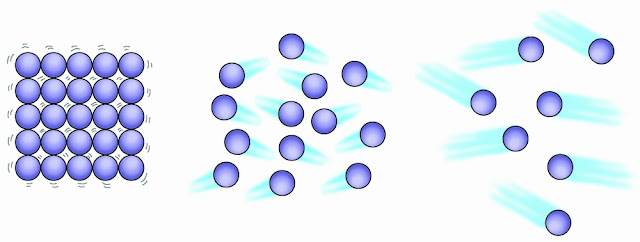As reference, here is a Periodic Table; you can refer to this as you go along the syllabus statements. If you didn't know already, you will be provided with a Periodic Table when you take you exams!
1. Describe the way the Periodic Table classifies elements in order of proton number.
Elements are ordered in numerical order according to the number of protons it contains. Hydrogen has one proton so it is first, followed by helium, lithium, etc.
2. Use the Periodic Table to predict properties of elements by means of groups and periods.
On the Periodic Table there are groups. The important ones that the syllabus covers are alkali metals (group 1), transition metals (group 3), halogens (group 7) and noble gases (group 0/8).
Unit 9.1 Periodic Trends
1. Describe the change from metallic to non-metallic character across a period.
As you run across the Periodic Table horizontally, the character of the element goes from metallic to non-metallic.
2. Describe the relationship between Group number, number of outer-shell (valency) electrons and metallic /non-metallic character.
The valency of the outer shell depends on what group the element is in. Here's a little advice: once you get your Periodic Table in the exam, start from Group 1 and label +1, +2, +3, +4, -3, -2, -1, full, ending on Group 8. This determines the valency of the element, helping you to balance equations.
Unit 9.2 Group Properties
1. Describe lithium, sodium and potassium in Group I as a collection of relatively soft metals showing a trend in melting point and reaction with water.
| Metal | Hardness | Reactivity | Melting point | Reaction with water |
|---|---|---|---|---|
| Lithium | Soft | Reactive | 180.5°c | Fizzes on water, releases hydrogen |
| Sodium | Softer | More reactive | 97.7°c | Fizzes on water, burns with a yellow flame, release hydrogen |
| Potassium | Softest | Most reactive | 63.4°c | Fizzes on water, burns with a lilac flame, release hydrogen |
From my experience, exam boards like to throw in a question worth 6-9 marks about lithium, sodium and potassium comparisons, so it's worth remembering these points.
Properties of alkali metals
• relatively soft metals
• low boiling and melting points --> decrease as you go down the group
• reacts with water to form metal hydroxide + hydrogen
• reacts with oxygen to form metal oxide
• reactivity increases as you go down the group
• densities increase as you go down the group
3. Describe the trends in properties of chlorine, bromine and iodine in Group VII including colour, physical state and reactions with other halide ions.
| Halogen | State at room temperature | Colour | Reaction with halide ions |
|---|---|---|---|
| Chlorine | Gas | Yellow-green | Oxidises bromine and below |
| Bromine | Liquid | Red-brown | Oxidises iodine and below |
| Iodine | Solid | Purple | Oxidises astatate and below |
4. Predict the properties of other elements in
Group VII, given data where appropriate.
Properties of halogens
• melting and boiling points increase as you go down the group
• reactivity decreases as you go down the group
• kills bacteria
• react with metals to form metal halides
Unit 9.3 Transition Elements
1. Describe the transition elements as a
collection of metals having high densities,
high melting points and forming coloured
compounds, and which, as elements and
compounds, often act as catalysts.
Properties of transition metals
• high densities
• high melting points
• forms coloured compounds
• can act as catalysts
Unit 9.4 Noble Gases
1. Describe the noble gases as being
unreactive.
Noble gases are unreactive because their outer shells are full. This means that they are stable without having to gain or lose electrons. They are also described as inert.
2. Describe the uses of the noble gases in
providing an inert atmosphere, i.e. argon in
lamps, helium for filling balloons.
Under normal conditions, noble gases are odourless, colourless and nonflammable.
• argon is used in lightbulbs
• helium is used to inflate tires and balloons
• neon is used in neon lights because it glows when electricity is passed through it
• xenon is used in photocopying






